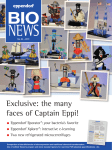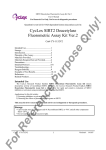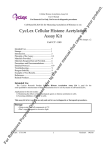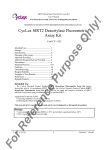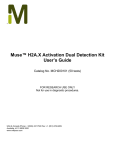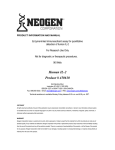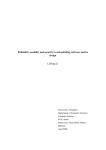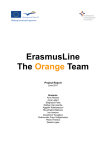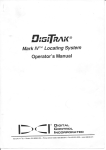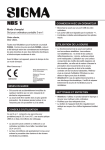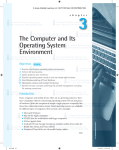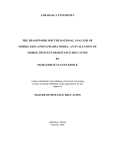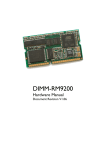Download Data Sheet
Transcript
On ly! Histone H2A.X Phosphorylation Cellular ELISA Kit User’s Manual For Research Use Only, Not for use in diagnostic procedures Cell-Based ELISA Kit for Measuring phosphorylation of Histone H2A.X in situ CycLex Histone H2A.X Phosphorylation Cellular ELISA Kit 96 Assays x 2 Pu Intended Use................................................ 1 Storage......................................................... 1 Introduction.................................................. 2 Principle of the Assay.................................. 2-3 Materials Provided....................................... 4 Materials Required but not Provided........... 4 Precautions and Recommendations............. 5 Detailed Protocol......................................... 6-9 Troubleshooting........................................... 9 Reagent Stability...........................................9 Example of Test Results..............................10-11 References................................................... 12 Related Products......................................... 12 rp os e Cat# CY-1143 Intended Use ce The CycLex Research Product Histone H2A.X Phosphorylation Cellular ELISA Kit is a non-isotopic immunoassay used for the semi-quantitative measurement of histone H2A.X phosphorylation level in response to DNA double strand break in situ by means of cell-based ELISA. en Applications for this kit include: 1) Monitoring the effects of pharmacological agents on histone H2A.X phosphorylation in cells. 2) Study on the DNA double-strand break repair mechanisms in situ. 3) Screening compounds cause DNA double strand break in cells. Storage er This assay kit is for research use only and not for use in diagnostic or therapeutic procedures. rR ef • Upon receipt store all components at 4°C. • Don’t expose reagents to excessive light. Fo Cat#: CY-1143 1 Version#: 120420 On ly! Histone H2A.X Phosphorylation Cellular ELISA Kit User’s Manual For Research Use Only, Not for use in diagnostic procedures Introduction rp os e Histone H2A.X has been implicated in the maintenance of genomic stability in response to DNA double strand breaks (DSBs). It is phosphorylated at an evolutionary conserved PI3 kinase related kinase motif in the carboxyl terminus within seconds after exposure to ionizing radiation (IR) (1). Immunofluorescence studies have revealed that phosphorylated H2AX (γ-H2AX) forms nuclear foci at the sites of DSBs. These foci appear within 1 min after exposure of cells to IR. Their numbers increase in the first 10-30 min after irradiation before they gradually decline correlating with the predicted value of slowly re-joining DSBs (2). γ-H2AX foci are also found at sites of V(D)J recombination-induced DSBs in developing thymocytes (3) and at sites of recombinational DSBs during meiosis (4). In addition, phosphorylation of H2AX is also induced by initiation of DNA fragmentation during apoptosis (5). Thus, H2AX is phosphorylated in response to DSBs. Principle of the Assay rR ef er en ce Pu The CycLex Histone H2A.X Phosphorylation Cellular ELISA Kit based on the phosphorylation of the histone H2A.X at serine139 in response to ionizing radiation or DNA damaging reagent which cause DNA double strand break in cells that are cultured in microtiter plates. During treatment of genotoxic reagent is carried out on wells of the microtiter plate, histone H2A.X will be phosphorylated at serine 139 in the living cells. To enable antibody binding to the phosphorylated histone H2A.X, cells must be fixed and permeabilized. Detector anti-phospho-histone H2A.X (S139) monoclonal antibody, clone TK-2F1 is pipetted into the wells and allowed to incubate for one hour, during which time it binds to any the phosphorylated histone H2A.X. Unbound antibody is washed away and horseradish peroxidase-conjugated goat anti-mouse IgG is added, which binds to the detector antibody. The horseradish peroxidase catalyzes the conversion of the chromogenic substrate tetra-methylbenzidine (TMB) from a colorless solution to a blue solution (or yellow after the addition of stopping reagent). The color is quantified by spectrophotometry and reflects the relative amount of phosphorylated histone H2A.X in the cells. Fo Cat#: CY-1143 2 Version#: 120420 On ly! Histone H2A.X Phosphorylation Cellular ELISA Kit User’s Manual For Research Use Only, Not for use in diagnostic procedures The CycLex Histone H2A.X Phosphorylation Cellular ELISA Kit is designed to measure the relative levels of phosphorylated histone H2A.X in situ. The summary of the assay is shown in below. Summary of Procedure for adherent cells Culture adherent cells in microplate at 1-5 x 104 cells/well. Incubate O/N at 37°C in CO2 incubator rp os e Add appropriate amount of test compound for induction of DNA double strand break Incubate appropriate time at 37°C in CO2 incubator Discard the culture medium and wash the microplate Add 150 µL of ice-cold 95 % methanol for fixation Stand for 10 min at room temp. Discard the methanol Pu Add 200 µL of Blocking Reagent Incubate for at least 2 hr at 37°C or O/N at 4°C Add 50 µL of Anti-Phospho-Histone H2A.X (S139) Monoclonal Antibody Incubate 1 hr at room temp. ce Wash the wells Add 50 µL of HRP conjugated Anti-Mouse IgG Incubate 1 hr at room temp. en Wash the wells Add 50 µL of Substrate Reagent er Add 50 µL of Stop Solution rR ef Measure absorbance at 450 nm Fo Cat#: CY-1143 3 Version#: 120420 Materials Provided On ly! Histone H2A.X Phosphorylation Cellular ELISA Kit User’s Manual For Research Use Only, Not for use in diagnostic procedures All compounds treatment and positive control (Camptothecin treatment) should be assayed in duplicate. The following components are supplied and are sufficient for the two 96-well microplates. Microplate: Two 96-well cell culture plates 100X Camptothecin: One vial containing 50 µL of 2 mM Camptothecin in DMSO rp os e 10X Wash Buffer: One 100 mL bottle of 10X buffer containing 2%Tween®-20 Blocking Reagent: Two bottles containing 20 mL of 1X Blocking Reagent. Ready to use. Primary Antibody Solution (Anti-Phospho-Histone H2A.X (S139) Monoclonal Antibody): One vial containing 12 mL of anti-phospho-histone H2A.X (S139) monoclonal antibody, TK-2F1. Ready to use. Secondary Antibody Solution (HRP conjugated Anti-Mouse IgG): One vial containing 12 mL of HRP (horseradish peroxidase) conjugated anti-mouse IgG polyclonal antibody. Ready to use. Substrate Reagent: 20 mL of the chromogenic substrate, tetra-methylbenzidine (TMB). Ready to use. Pu Stop Solution: One bottle supplied ready to use, containing 20 mL of 1 N H2SO4. Materials Required but not Provided rR ef er en ce •Cell culture flasks for growing and splitting cells. •Cell culture media •Ice-cold 95 % Methanol for 1st fixation of cells •1% paraformaldehyde in PBS for 2nd fixation of cells •1X PBS pH 7.2 • Pipettors: 2-20 µL, 20-200 µL and 200-1000 µL precision pipettors with disposable tips. • Precision repeating pipettor • Orbital microplate shaker • Microcentrifuge and tubes for sample preparation. • Vortex mixer • Microplate washer: optional (Manual washing is possible but not preferable) • Software package facilitating data generation and analysis :optional • 500 or 1000 mL graduated cylinder. • Reagent reservoirs • Deionized water of the highest quality. • Absorbent paper: disposable paper towels • Plate reader capable of measuring absorbance in 96-well plates at dual wavelengths of 450 nm/540 nm. Dual wavelengths of 450/550 or 450/595 nm can also be used. The plate can also be read at a single wavelength of 450 nm, which will give a somewhat higher reading. Fo Cat#: CY-1143 4 Version#: 120420 On ly! Histone H2A.X Phosphorylation Cellular ELISA Kit User’s Manual For Research Use Only, Not for use in diagnostic procedures Precautions and Recommendations Safety Warnings and Precautions: The Histone H2A.X Phosphorylation Cellular ELISA Kit is designed for research use only and not recommended for internal use in humans or animals. All chemicals should be considered potentially hazardous and principles of good laboratory practice should be followed. Technical Notes Pu rp os e 1. When performing washes manually, avoid introducing bubbles when dispensing liquids into the wells, and ensure each well is filled with buffer, but not overflowing to avoid cross-contamination between wells. Empty wells with a wrist-flick motion over an appropriate receptacle, and while still inverted, blot any remaining moisture onto clean absorbent paper. 2. Agitation of wells during incubation of Blocking Buffer and Antibody steps is recommended to reduce non-specific background. If microtiter plate agitator is not available, a platform vortex at a low setting can be used (e.g. level 1 of Fisher’s Genie II platform vortex). If background problems occur, simply increase the number and/or duration of washes. 3. A brief 1X PBS rinse is recommended prior to the addition of the HRP substrate to remove any traces of the Tween-20™ with can interfere with the HRP activity. 4. Do not allow the wells to dry out during the protocol. 5. Incubation temperatures for Primary Antibody and Detection Antibody can be varied and should be empirically determined. General Notes • Allow all the components to come to room temperature before use. • Do not use kit components beyond the indicated kit expiration date. ce • Rinse all detergent residue from glassware. • Use deionized water of the highest quality. en • Do not mix reagents from different kits. • The buffers and reagents used in this kit contain NaN3 as preservatives. Care should be taken to avoid direct contact with these reagents. er • Dispose of tetra-methylbenzidine (TMB) containing solutions in compliance with local regulations. • Avoid contact with the acidic Stop Solution and Substrate Solution, which contains hydrogen peroxide. ef • Wear gloves and eye protection when handling immunodiagnostic materials and samples of human origin, and these reagents. In case of contact with the Stop Solution and the Substrate Solution, wash skin thoroughly with water and seek medical attention, when necessary. rR • CAUTION: Sulfuric Acid is a strong acid. Wear disposable gloves and eye protection when handling Stop Solution. Fo Cat#: CY-1143 5 Version#: 120420 On ly! Histone H2A.X Phosphorylation Cellular ELISA Kit User’s Manual For Research Use Only, Not for use in diagnostic procedures Detailed Protocol The CycLex Research Product Histone H2A.X Phosphorylation Cellular ELISA Kit includes all reagents except cell fixative. Since experimental conditions may vary, treatment cells with Camptothecin within the kit should be included in each experiment as a positive control for induction of histone H2A.X phosphorylation. Disposable pipette tips and reagent troughs should be used for all liquid transfers to avoid cross-contamination of reagents or samples. Preparation of Reagents rp os e All reagents need to be brought to room temperature prior to the assay. Assay reagents are supplied ready-to-use, with the exception of 10X Wash Buffer. 1. Prepare a working solution of Wash Buffer by adding 100 mL of the 10X Wash Buffer (provided) to 900 mL of deionized (distilled) water. Mix well. 2. 95 % MetOH: For each 96-well plate, add 1 mL H2O to 19 mL of methanol. Cool in –20°C freezer. This solution must be prepared fresh. Discard unused portion following assay completion. Pu 3. 1% paraformaldehyde in PBS: For each 96-well plate, dissolve 0.2 g of paraformaldehyde in 20 mL of PBS pH7.2. This solution must be prepared fresh. Discard unused portion following assay completion. Assay Procedure A. Culture adherent cells in 96-well microplate and treatment with compounds ce 1. Plate adherent cells in 96-well microplate at 1-5 x 104 cells/well. 2. Incubate the microplate at 37°C over night in CO2 incubator. en 3. Add appropriate amount of test compounds to each well. Camptothecin treatment* should be run in duplicate as a positive control for induction of histone H2A.X phosphorylation. Please include vehicle control, e.g. H2O in case of Camptothecin. 4. Incubate the microplate at 37°C for appropriate time. rR ef er *Camptothecin treatment: Treat the cells with 20 µM Camptothecin for 0, 0.25, 0.5, 1, 2, 3, 4 and 6 hours. Fo Cat#: CY-1143 6 Version#: 120420 B. Fixing cells to 96-well microplate and blocking (Single Fixation protocol) On ly! Histone H2A.X Phosphorylation Cellular ELISA Kit User’s Manual For Research Use Only, Not for use in diagnostic procedures Fixing of the cells in the 96-well plates should be done as soon as the desired treatment has completed. 1. Remove media from wells with a wrist-flick. Avoid touching the bottom of the well and removing cells. 2. Immediately add 150 µL/well of 95 % MetOH as a fixative, slowly to insure cells are not detached from the plastic. Let stand for 10 minutes at room temperature (ca.25°C). rp os e 3. Remove 95 % MetOH from wells with a wrist-flick. While still inverted, tap the plate gently onto absorbent paper to remove any excess fixing agent still within the wells. 4. Add 200 µL/well Wash Buffer. Let stand for 1 minute at room temperature (ca.25°C). 5. Remove wash buffer with a wrist-flick. While still inverted, gently tap the plate onto absorbent paper to remove any excess liquid. 6. Add 200 µL/well Blocking Reagent and incubate for 2 hours at 37°C or overnight at 4°C. Alternatively: In cases where the cells are easy to detach from 96-well plates even aftter1st fixation. Pu B’. Fixing cells to 96-well microplate and blocking (Double Fixation protocol) 1’. Remove media from wells with a wrist-flick. Avoid touching the bottom of the well and removing cells. ce 2’. Immediately add 150 µL/well of 95 % MetOH as a fixative, slowly to insure cells are not detached from the plastic. Let stand for 10 minutes at room temperature (ca.25°C). 3’. Remove 95 % MetOH from wells with a wrist-flick. While still inverted, tap the plate gently onto absorbent paper to remove any excess fixing agent still within the wells. en 4’. Add 150 µL/well of 1 % paraformaldehyde in PBS, slowly to ensure cells are not dislodged from the wells. Let stand for 5 minutes at room temperature (ca.25°C). 5’. Remove paraformaldehyde solution from wells with a wrist-flick. While still inverted, gently tap the plate onto absorbent paper to remove any excess liquid still in the wells. er 6’. Add 200 µL/well Wash Buffer. Let stand for 1 minute at room temperature (ca.25°C). ef 7’. Remove wash buffer with a wrist-flick. While still inverted, gently tap the plate onto absorbent paper to remove any excess liquid. rR 8’. Add 200 µL/well Blocking Reagent and incubate for 2 hours at 37°C or overnight at 4°C. Fo Cat#: CY-1143 7 Version#: 120420 On ly! Histone H2A.X Phosphorylation Cellular ELISA Kit User’s Manual For Research Use Only, Not for use in diagnostic procedures C. Detection of Signals (Addition of Primary and Secondary Antibodies and Substrate Reagent) 1. Remove Blocking Reagent with a wrist-flick. 2. Rinse the wells once with 200 µL/well of Wash Buffer. This can be achieved either by using a multichannel pipette or a manifold. 3. Remove Wash Buffer with a wrist-flick. While the plate is still inverted, tap onto absorbent paper to remove any excess buffer within the wells. rp os e 4. Add 50 µL/well of Primary Antibody Solution into each well. 5. Incubate the plate for 1 hour at room temperature (ca.25°C), shaking at ca. 300 rpm on an orbital microplate shaker. 6. Remove Primary Antibody Solution with a wrist-flick. 7. Rinse the wells once with 200µl/well of Wash Buffer. 8. Remove Wash Buffer with a wrist-flick. While still inverted, tap the plate onto absorbent paper. Pu 9. Wash wells 4 times with 200 µL/well Wash Buffer for 2 minutes each with shaking at ca. 200 rpm on an orbital microplate shaker. Remove Wash Buffer in-between each wash with a wrist-flick. 10. Add 50 µL/well of Secondary Antibody Solution into each well. 11. Incubate the plate for 1 hour at room temperature (ca.25°C), shaking at ca. 300 rpm on an orbital microplate shaker. ce 12. Remove Secondary Antibody Solution with a wrist-flick. 13. Rinse wells once with 200 µL/well Wash Buffer. en 14. Remove Wash Buffer with wrist-flick and tap plate onto absorbent paper. 15. Wash wells 4 times with 200 µL/well Wash Buffer for 2 minutes each with shaking at ca. 200 rpm on an orbital microplate shaker. Remove Wash Buffer in-between each wash with a wrist-flick. er 16. After last wash with Wash Buffer, rinse wells once with 300 µl/well 1X PBS. Remove with a wrist-flick and tap onto absorbent paper. Ensure that that no liquid remains in the well. ef 17. Add 50 µL/well of Substrate Reagent. (Avoid exposing the microplate to direct sunlight Covering the plate with e.g. aluminum foil is recommended). Return Substrate Reagent to 4°C immediately after the necessary volume is removed. rR 18. Incubate the plate for 10-20 minutes at room temperature (ca.25°C) ), shaking at ca. 300 rpm on an orbital microplate shaker.(The incubation time may be extended up to 30 minutes if the reaction temperature is below than 20°C). 19. Add 50 µL of Stop Solution to each well in the same order as the previously added Substrate Reagent. Fo Cat#: CY-1143 8 Version#: 120420 On ly! Histone H2A.X Phosphorylation Cellular ELISA Kit User’s Manual For Research Use Only, Not for use in diagnostic procedures 20. Measure absorbance in each well using a spectrophotometric microplate reader at dual wavelengths of 450/540 nm. Dual wavelengths of 450/550 or 450/595 nm can also be used. Read the microplate at 450 nm if only a single wavelength can be used. Wells must be read within 30 minutes of adding the Stop Solution*. Note-1: Complete removal of liquid at each step is essential to good performance. After the last wash, remove any remaining Wash Buffer by aspirating or decanting. Invert the plate and blot it against clean paper towels. rp os e Note-2: If the microplate reader is not capable of reading absorbance greater than the absorbance of the highest standard, perform a second reading at 405 nm. A new standard curve, constructed using the values measured at 405 nm, is used to determine of histone H2A.X phosphorylation level of off-scale samples. The readings at 405 nm should not replace the on-scale readings at 450 nm. Troubleshooting 1. The signals are influenced a great deal by cell line and cell number that you plated, please ensure the appropriate cell number for your experiment. See “Example of Test Results Fig.2”. Pu 2. Unavoidable background (at Treatment time 0 hr or vehicle control) is observed even if an appropriate cells number is used. It is usually around 0.2-0.3. See “Example of Test Results Fig.1”. 3. With some cell lines, higher cell concentrations (more than 1 × 105 cells/well in case of adherent cells) may lead to increasing absorbance values in vehicle control (background) rather than those in Camptothecin treatment. ce 4. All treatments including treatment of Camptothecin should be run in duplicate, using the protocol described in the Detailed Protocol. Incubation times or temperatures significantly different from those specified may give erroneous results. en 5. Poor duplicates, accompanied by elevated values for wells containing non-treated cells (vehicle control), indicate insufficient washing or vigorous washing. Wash the plate thoroughly and gently. 6. Overall low signal may indicate that desiccation of the plate has occurred between the final wash and addition of Substrate Reagent. Do not allow the plate to dry out. Add Substrate Reagent immediately after wash. er Reagent Stability ef All of the reagents included in the CycLex Research Product Histone H2A.X phosphorylation Cellular ELISA Kit have been tested for stability. Reagents should not be used beyond the stated expiration date. Upon receipt, kit reagents should be stored at 4°C. rR For research use only, not for use in diagnostic or therapeutic procedures Fo Cat#: CY-1143 9 Version#: 120420 On ly! Histone H2A.X Phosphorylation Cellular ELISA Kit User’s Manual For Research Use Only, Not for use in diagnostic procedures Example of Test Results Fig.1 Typical result of time course experiment using HeLa cells treated with 10 µM SN38 25,000cells/wel 50,000 cells/well 1.2 0.9 0.8 1.0 0.7 A450 A450 0.5 0.4 rp os e 0.8 0.6 0.6 0.4 0.3 0.2 0.2 0.1 0.0 0.0 1 2 3 SN38 Treatment Time (hr) 4 0 5 1 2 3 4 5 SN38 Treatment Time (hr) Pu 0 Fig.2 Effect of cell number on ELISA value using HeLa cells 1.2 0 hr 0.5 hr 1 hr 2 hr ce 1.0 0.8 en A450 10 uM SN38 0.6 er 0.4 0.2 rR ef 0.0 Fo Cat#: CY-1143 0 12,500 25,000 Cells/Well 10 50,000 Version#: 120420 On ly! Histone H2A.X Phosphorylation Cellular ELISA Kit User’s Manual For Research Use Only, Not for use in diagnostic procedures Fig.3 Effect of Camptothecin on phosphorylation of histone H2A.X in HeLa. The cells (2.5 x 104 /well) were treated with indicated concentration of drugs for 1 hr. Dose dependency of Camptothecine 2.0 1.8 1.4 A450 1.2 1.0 0.8 0.6 rp os e 1.6 50000 cell/well 25000 cell/well 12500 cell/well 6250 cell/well 0.4 0.2 0.0 0.01 0.10 1.00 10.00 Pu 0.00 100.00 rR ef er en ce Camptothecin (uM) Fo Cat#: CY-1143 11 Version#: 120420 On ly! Histone H2A.X Phosphorylation Cellular ELISA Kit User’s Manual For Research Use Only, Not for use in diagnostic procedures References rp os e 1. Burma S, Chen BP, Murphy M, Kurimasa A, Chen DJ ATM phosphorylates histone H2AX in response to DNA double-strand breaks. J Biol Chem. 2001 Nov 9;276(45):42462-7. 2. Bassing CH, Suh H, Ferguson DO, Chua KF, Manis J, Eckersdorff M, Gleason M, Bronson R, Lee C, Alt FW. Histone H2AX: a dosage-dependent suppressor of oncogenic translocations and tumors. Cell. 2003 Aug 8;114(3):359-70. 3. Kobayashi J, Tauchi H, Sakamoto S, Nakamura A, Morishima K, Matsuura S, Kobayashi T, Tamai K, Tanimoto K, Komatsu K. NBS1 localizes to gamma-H2AX foci through interaction with the FHA/BRCT domain. Curr Biol. 2002 Oct 29;12(21):1846-51. 4. Celeste A, Fernandez-Capetillo O, Kruhlak MJ, Pilch DR, Staudt DW, Lee A, Bonner RF, Bonner WM, Nussenzweig A. Histone H2AX phosphorylation is dispensable for the initial recognition of DNA breaks. Nat Cell Biol. 2003 Jul;5(7):675-9. 5. Rogakou EP, Pilch DR, Orr AH, Ivanova VS, Bonner WM. DNA double-stranded breaks induce histone H2AX phosphorylation on serine 139. J Biol Chem. 1998 Mar 6;273(10):5858-68. 6. Rogakou EP, Nieves-Neira W, Boon C, Pommier Y, Bonner WM. Initiation of DNA fragmentation during apoptosis induces phosphorylation of H2AX histone at serine 139. J Biol Chem. 2000 Mar 31;275(13):9390-5. Pu Related Products PRODUCED BY en ce * CycLex Cellular Histone Acetylation Assay Kit: Cat# CY-1140 * CycLex Cellular UV DNA-Damage Detection Kit: Cat# CY-1141 * CycLex BrdU Cellular ELISA Kit: Cat# CY-1142 * CycLex Histone H2A.X Phosphorylation Cellular ELISA Kit: Cat# CY-1143 ef er CycLex Co., Ltd. 1063-103 Terasawaoka Ina, Nagano 396-0002 Japan Fax: +81-265-76-7618 e-mail: [email protected] URL: http://www.cyclex.co.jp rR CycLex/CircuLex products are supplied for research use only. CycLex/CircuLex products and components thereof may not be resold, modified for resale, or used to manufacture commercial products without prior written approval from CycLex Co., Ltd.. To inquire about licensing for such commercial use, please contact us via email. Fo Cat#: CY-1143 12 Version#: 120420












